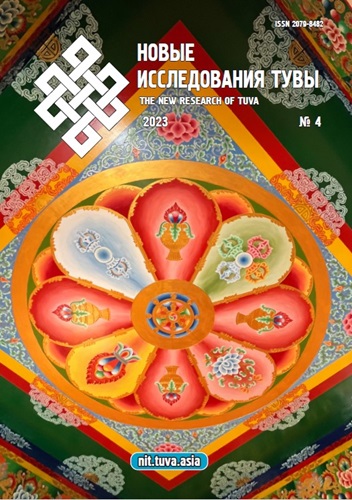Teenagers of Kyzyl (Republic of Tuva) in the online space
DOI:
https://doi.org/10.25178/nit.2023.4.17Keywords:
adolescent; Tuva; Kyzyl; Internet; online behavior; addiction; consumed content; Tuvans; RussiansAbstract
The study is dedicated to investigating the prevalence of various internet usage patterns, including adaptive (API), non-adaptive (NPI), and pathological (PPI) behaviors, as well as examining the characteristics of internet content consumed by adolescents in Tuva, considering their diverse age, gender, and ethnic backgrounds. The research findings are based on the analysis of offline testing results conducted among adolescents in Kyzyl, serving as the empirical foundation for this article. The surveys were carried out through a random sampling method from December 2020 to May 2021, involving 1659 participants who completed three psychometric instruments (CIAS scale), along with questionnaires for verifying dependence on social networks and gaming addiction.
A comparative analysis of indicators was performed among groups differing in terms of age, gender, and ethnic background (Tuvans, Russians). The study revealed the prevalence of internet-dependent behavior and the specific structure of internet activity content consumed within the comparison groups. Adaptive internet usage (API) was observed in 34.3% of all participants, non-adaptive internet usage (NPI) in 51.3%, and pathological internet usage (PPI) or internet addiction in 14.4% of adolescents.
Particular attention was paid to examining the impact of ethnic background on online behavior among adolescents. The study found a higher frequency of maladaptive (NPI and PPI) online behaviors among Tuvan adolescents. Gender differences were also noted, including a higher incidence of PPI among Tuvan girls compared to Tuvan boys. NPI was more frequently recorded among Tuvan adolescents (both boys and girls). Regarding the analyzed indicators and their correlation with age, significant age-related differences were not identified across all types of online behavior, except for younger Tuvan adolescents, where NPI was more prevalent.
The analysis of consumed internet content revealed dependency on social networks in 13.9% of adolescents, gaming addiction in 5.2%, mixed addiction in 9.2%, and undifferentiated addiction in 5.4% (with no significant ethnic differences observed). Gender differences were identified in the prevalence of various types of internet addiction: gaming addiction was higher among Tuvan boys, undifferentiated addiction was more common among girls, and dependency on social networks was more prevalent among girls, both Tuvan and Russian. Among boys, this dependency was higher among Tuvan boys compared to their Russian counterparts.
References
Vainshtein, A. (2015) Internet-zavisimost': diagnostika, komorbidnost' i lechenie [Internet addiction: diagnosis, comorbidity and treatment]. Meditsinskaia psikhologiia v Rossii, vol. 33, no. 4, pp. 3 [online] Available at: http://www.mprj.ru/archiv_global/2015_4_33/nomer05.php (access: 10.07.2023). (In Russ.).
Varlamova, S. N., Goncharova, E. R. and Sokolova, I. V. (2015) Internet-zavisimost' molodezhi megapolisov: kriterii i tipologiia [Internet addiction of the youth of megacities: criteria and typology]. Monitoring obshchestvennogo mneniia. Ekonomicheskie i sotsial'nye peremeny, no. 2, pp. 165–181. (In Russ.). DOI: https://doi.org/10.14515/monitoring.2015.2.11
Voprosy sovremennoi nauki [Questions of modern science] (2021) / ed. by A. A. Enikeeva. Moscow, Internauka. Vol. 65. 150 p. (In Russ.).
Egorov, A. Yu., Grechanyi, S. V., Chuprova, N. A., Soldatkin, V. A., Iakovlev, A. N., Iliuk, R. D., Nikolishin, A. E., Ponizovskii, P. A., Vantei, V. B., Gromyko, D. I., Dolgikh, N. V., Erofeeva, N. A., Pozdniak, V. V., Il'ichev, A. B., Khutorianskaia, Iu. V., Egorov, A. A., Magomedova, E. A., Nechaeva, A. I., Pashkevich, N. V., Semenova, Iu. V., Sidorov, A. A., Khanykov, V. V., Kibitov, A. A., Krupitskii, E. M., Shmukler, A. B. and Kibitov, A. O. (2020) Kliniko-psikhopatologicheskie osobennosti lits s internet-zavisimost'iu: opyt pilotnogo issledovaniia [Clinical and psychological features of people with internet dependence: experience of a pilot study]. Zhurnal Nevrologii i Psikhiatrii imeni S.S. Korsakova, vol. 120, no. 3, pp. 13–19. (In Russ.). DOI: https://doi.org/10.17116/jnevro202012003113
Egorov, A. Yu. (2015) Sovremennye predstavleniia ob internet-addiktsiiakh i podkhodakh k ikh korrektsii [Modern ideas about Internet addiction and approaches to their correction]. Meditsinskaia psikhologiia v Rossii, vol. 33, no. 4, p. 4 [online] Available at: http://mprj.ru/archiv_global/2015_4_33/nomer01.php (access: 28.07.2023). (In Russ.).
Egorov, A. Yu., Charnaia, D. I., Khutorianskaia, Iu. V., Pavlov, A. V. and Grechanyi, S. V. (2018) Internet-zavisimoe povedenie u podrostkov s psikhicheskimi rasstroistvami [Internet-dependent behavior in adolescents with mental disorders]. V. M. Bekhterev Review Of Psychiatry And Medical Psychology, no. 4, pp. 35–45. (In Russ.). DOI: https://doi.org/10.31363/2313-7053-2018-4-35-45
Kekeeva Z. O., Uvarova G. N., Darzhinova S. V., Mueva A. V. and Oorzhak A. B. (2022) Issledovanie setevoi identichnosti studencheskoi molodezhi regionov Rossii (na primere Kalmykii i Tuvy) [Research on the network identity of the student youth of Russian regions (the cases of Kalmykia and Tuva)]. New Research of Tuva, no. 4, pp. 169–179. (In Russ.). DOI: https://doi.org/10.25178/nit.2022.4.13
Kibitov, A. O., Trusova, A. V. and Egorov, A. Yu. (2019) Internet-zavisimost': klinicheskie, biologicheskie, geneticheskie i psikhologicheskie aspekty [Internet addiction: clinical, biological, genetic and psychological aspects]. Voprosy narkologii, vol. 174, no. 3, pp. 22–47. (In Russ.). DOI: https://doi.org/10.47877/0234-0623_2019_3_22
Kibitov, A. O., Chuprova, N. A., Grechanyi, S. V., Solov'eva, M. G., Brodianskii, V. M., Merkulova T. V., Nikolishin A. E., Soldatkin V. A., Iakovlev A. N., Iliuk R. D., Krupitskii E. M., Shmukler A. B. and Egorov A. Yu. (2020) Geneticheskie markery riska vyrazhennosti simptomov i proiavlenii internet-zavisimosti po shkale CIAS: predvaritel'nye rezul'taty [Genetic markers of the risk of the severity of symptoms and manifestations of Internet addiction on the CRIES scale: preliminary results]. Voprosy narkologii, vol. 184, no. 1, pp. 60–82. (In Russ.). DOI: https://doi.org/10.47877/0234-0623_2020_1_60
Lamazhaa, Ch. K. (2021) Sotsial'naia kul'tura tuvintsev i onlain-prostranstvo [Social Culture of Tuvans and Online Space]. New Research of Tuva, no. 2, pp. 115–129. (In Russ.). DOI: https://www.doi.org/10.25178/nit.2021.2.10
Lopatin, D. V., Koroleva, N. L., Anur'eva, M. S., Puzanova, Ya. M., Ostapchuk, K. I. (2017) Problema bezopasnosti shkol'nikov v seti Internet [The problem of children’s security on the Internet]. Vestnik Tambovskogo universiteta. Seriia Estestvennye i tekhnicheskie nauki, vol. 22, issue 1, pp. 232–236. (In Russ.). DOI: https://doi.org/10.20310/1810-0198-2017-22-1-232-236
Makarova, I. A. and Reznikov, S. A. (2020) Organizatsiia profilaktiki internet-zavisimosti podrostkov v sovremennoi shkole [Organization of prevention of Internet addiction of adolescents in a modern school]. Voprosy pedagogiki, vol. 6, no. 2, pp. 143–146. (In Russ.).
Malygin, V. L. and Feklisov, K. A. (2011) Internet-zavisimoe povedenie. Kriterii i metody diagnostiki [Internet-dependent behavior. Diagnostic criteria and methods]. Moscow, MGMSU. 32 p. (In Russ.).
Malygin, V. L., Khomeriki, N. S. and Antonenko, A. A. (2015) Individual'no-psikhologicheskie svoistva podrostkov kak faktory riska formirovaniia internet-zavisimogo povedeniia [Individual psychological properties of adolescents as risk factors for the formation of Internet-dependent behavior]. Meditsinskaia psikhologiia v Rossii, vol. 30, no. 7, pp. 7 [online] Available at: http://mprj.ru/archiv_global/2015_4_33/nomer01.php (access: 28.07.2023). (In Russ.).
Ondar, Ch. G., Dongak, V. S. and Mongush, D. S. (2023) Tuvinskii iazyka v Internete: predstavlennost’, problemy i perspektivy [The Tuvan language on the Internet: Representation, problems and prospects]. New Research of Tuva, no. 1, pp. 186–207. (In Russ.). DOI: https://doi.org/10.25178/nit.2023.1.11
Rybakova, O. S. (2017) Zakonodatel'noe regulirovanie obespecheniia bezopasnosti rebenka v internet-prostranstve [Legislative regulation of child safety in the Internet space]. Pravovaia informatika, no. 4, pp. 49–54. (In Russ.).
Semenova, N. B., Tereshchenko, S. Iu., Evert, L. S., Zaitseva, O. I. and Shubina, M. V. (2020) Rasprostranennost' internet-zavisimosti u podrostkov Tsentral'noi Sibiri [Prevalence of Internet addiction among adolescents in Central Siberia]. Zdravookhranenie Rossiiskoi Federatsii, vol. 64, no. 1, pp. 36–44. (In Russ.).
Evert, L. S., Tereshchenko, S. Iu., Zaitseva, O. I., Semenova, N. B., Shubina, M. V. (2020) Internet-zavisimost' u podrostkov Tsentral'noi Sibiri: analiz rasprostranennosti i struktura potrebliaemogo kontenta [Internet addiction in adolescents in Central Siberia: analysis of prevalence and structure of consumed content]. Bulletin of Siberian Medicine, vol. 19, no. 4, pp. 189–197. (In Russ.). DOI: https://doi.org/10.20538/1682-0363-2020-4-189-197
Avila, G. B., Dos Santos, E. N., Jansen, K. and Barros, F. C. (2020) Internet addiction in students from an educational institution in Southern Brazil: prevalence and associated factors. Trends in Psychiatry and Psychotherapy, vol. 42, no. 4, pp. 302–310. DOI: https://doi.org/10.1590/2237-6089-2019-0098
Besirovis, E., Pajevis, I. (2020) Bihavioral Addictions in Childhood and Adolescence — Pandemic Knocking Door. Psychiatr Danub, vol. 32, no. 3, pp. 382–385. PMID: 33030458
Chen, S.-H., Weng, L.-J., Su, Y.-J., Wu, H.-M. and Yang, P.-F. (2003) Development of a Chinese Internet Addiction Scale and Its Psychometric Study. Chinese Journal of Psychology, vol. 45, no. 3, pp. 279–294. DOI: https://doi.org/10.1037/t44491-000
Doh, Y. Y., Kim, B., Lee, S. and Gweon, G. (2020) The Cyclic Value-Context Reinforcement Model of Problematic Internet Use: Empirical Validation Using a Thematic Analysis of Children's Counseling Data. Journal of Medical Internet Research, vol. 22, no. 7, e17996. DOI: https://doi.org/10.2196/17996
Durkee, T., Carli, V., Floderus, B., Wasserman, C., Sarchiapone, M. and Apter, A. (2016) Pathological Internet use and risk-behaviours among European adolescents. International Journal of Environmental Research and Public Health, vol. 13, no. 3, p. 294. DOI: https://doi.org/10.3390/ijerph13030294
Durkee, T., Kaess, M., Carli, V., Parzer, P., Wasserman, C., Floderus, B., Apter, A., Balazs, J., Barzilay, S., Bobes, J., Brunner, R., Corcoran, P., Cosman, D., Cotter, P., Despalins, R., Graber, N., Guillemin, F., Haring, C., Kahn, J.-P., Mandelli, L., Marusic, D., Mészáros, G., Musa, G. J., Postuvan, V., Resch, F., Saiz, P. A., Sisask, M., Varnik, A., Sarchiapone, M., Hoven, C. W. and Wasserman, D. (2012) Prevalence of pathological Internet use among adolescents in Europe: demographic and social factors. Addiction, vol. 107, no. 12, pp. 2210–2222. DOI: http://dx.doi.org/10.1111/j.1360-0443.2012.03946.x
Griffiths, M. D., Pontes, M. H. and Szabo, A. (2016) The impact of Internet-based specific activities on the perceptions of Internet addiction, quality of life, and excessive usage: A crosssectional study. Addictive Behaviors Reports, no. 1, pp. 19–25. DOI: https://doi.org/10.1016/j.abrep.2015.03.002
Heinze, K., Lin, A., Reniers, R. and Wood, S. J. (2016) Longer-term increased cortisol levels in young people with mental health problems. Psychiatry Research, vol. 236, pp. 98–104. DOI: https://doi.org/10.1016/j.psychres.2015.12.025
Jaiswal, A., Manchanda, S., Gautam, V., Goel, A. D., Aneja, J. and Raghav, P. R. (2020) Burden of internet addiction, social anxiety and social phobia among University students, India. Journal of Family Medicine and Primary Care, vol. 9, no. 7, pp. 3607–3612. DOI: https://doi.org/10.4103/jfmpc.jfmpc_360_20
Johansson, A. and Götestam, K. G. (2004) Internet addiction: characteristics of a questionnaire and prevalence in Norwegian youth. Scandinavian Journal of Psychology, vol. 45, no. 3, pp. 223–229. DOI: http://dx.doi.org/10.1111/j.1467-9450.2004.00398.x
Kaess, M., Durkee, T., Brunner, R., Carli, V., Parzer, P., Wasserman, C., Sarchiapone, M., Hoven, C., Apter, A., Balazs, J., Balint, M., Bobes, J., Cohen, R., Cosman, D., Cotter, P., Fischer, G., Floderus, B., Iosue, M., Haring, C., Kahn, J. P., Musa, G. J., Nemes, B., Postuvan, V., Resch, F., Saiz, P. A., Sisask, M., Snir, A., Varnik, A., Žiberna, J. and Wasserman, D. (2014) Pathological Internet use among European adolescents: psychopathology and self-destructive behaviours. European Child Adolescent Psychiatry, vol. 23, no. 11, pp. 1093–1102. DOI: http://dx.doi.org/10.1007/s00787-014-0562-7
Kaess, M., Parzer, P., Mehl, L., Weil, L., Strittmatter, E., Resch, F. and Koenig, J. (2017) Stress vulnerability in male youth with Internet Gaming Disorder. Psychoneuroendocrinology, vol. 77, pp. 244–251. DOI: https://doi.org/10.1016/j.psyneuen.2017.01.008
Karacic, S. and Oreskovic, S. (2017) Internet addiction through the phase of adolescence: a questionnaire study. JMIR Mental Health, vol. 4, no. 2, article e11. DOI: https://doi.org/10.2196/mental.5537
Lemmens, J. S., Valkenburg, P. M. and Peter, J. (2009) Development and validation of a Game Addiction Scale for Adolescents. Journal of Media Psychology, vol. 12, no. 1, pp. 77–95. DOI: https://doi.org/10.1080/15213260802669458
Lindenberg, K., Halasy, K., Szász-Janocha, C. and Wartberg, L. (2018) A Phenotype Classification of Internet Use Disorder in a Large-Scale High-School Study. International Journal of Environmental Research and Public Health, vol. 15, no. 4. DOI: http://dx.doi.org/10.3390/ijerph15040733
Mak, K. K., Lai, C. M., Ko, C. H., Chou, C., Kim, D. I., Watanabe, H. and Ho, R. C. M. (2014) Psychometric properties of the Revised Chen Internet Addiction Scale (CIAS-R) in Chinese adolescents. Journal of Abnormal Child Psychology, vol. 42, no. 7, pp. 1237–1245. DOI: http://dx.doi.org/10.1007/s10802-014-9851-3
Miao, X., Jiang, X., Wang, P., Li, H., Wang, M. and Zeng, H. (2018) Online activities, prevalence of internet addiction and risk factors related to family and school among adolescents in China. Addictive Behaviors Reports, vol. 7, pp. 14–18. DOI: https://doi.org/10.1016/j.abrep.2017.10.003
Müller, K. W., Dreier, M., Duven, E., Giralt, S., Beutel, M. E. and Wölfling, K. (2017) Adding Clinical Validity to the Statistical Power of Large-Scale Epidemiological Surveys on Internet Addiction in adolescence: a combined approach to investigate psychopathology and development-specific personality traits associated with Internet addiction. Journal of Clinical Psychiatry, vol. 78, no. 3, e244-e51. DOI: http://dx.doi.org/10.4088/JCP.15m10447
Peterka-Bonetta, J., Sindermann, C., Sha, P., Zhou, M. and Montag, C. (2019) The relationship between Internet Use Disorder, depression and burnout among Chinese and German college students. Addictive Behaviors Reports, vol. 89, no. 2, pp. 188–199. DOI: https://doi.org/10.1016/j.addbeh.2018.08.011
Reiner, I., Tibubos, A. N., Hardt, J., Müller, K., Wölfling, K. and Beutel, M. E. (2017) Peer attachment, specific patterns of internet use and problematic internet. 33in male and female adolescents. European Child and Adolescent Psychiatry, vol. 26, no. 10, pp. 1257–1268. DOI: https://doi.org/10.1007/s00787-017-0984-0
Sasmaz, T., Oner, S., Kurt, A. Ö., Yapici, G., Yazici, A. E., Bugdayci, R. and Sis, M. (2014) Prevalence and risk factors of Internet addiction in high school students. European Journal of Public Health, vol. 24, no. 1, pp. 15–20. DOI: http://dx.doi.org/10.1093/eurpub/ckt051
Soh, P. C., Chew, K. W., Koay, K. Y. and Ang, P. H. (2018) Parents vs peers’ influence on teenagers’ Internet addiction and risky online activities. Telematics and Informatics, vol. 35, no. 1, pp. 225–236. DOI: https://doi.org/10.1016/j.tele.2017.11.003
Tereshchenko, S. and Kasparov, E. (2019) Neurobiological Risk Factors for the Development of Internet Addiction in Adolescents. Behavioral Sciences, vol. 6, no. 9, pp. 62–67. DOI: https://doi.org/10.3390/bs9060062
Torres-Rodríguez, A., Griffiths, M. D., Carbonell, X. and Oberst, U. (2018) Internet gaming disorder in adolescence: Psychological characteristics of a clinical sample. Journal of Behavioral Addictions, vol. 7, no. 3, pp. 707–718. DOI: http://dx.doi.org/10.1556/2006.7.2018.75
Tsitsika, A., Janikian, M., Schoenmakers, T. M., Tzavela, E. C., Olafsson, K., Wójcik, S, Macarie, G. F., Tzavara, C. and Richardson, C. (2014) Internet addictive behavior in adolescence: a cross-sectional study in seven European countries. Cyberpsychology, Behavior, and Social Networking, vol. 17, no. 8, pp. 528–535. DOI: http://dx.doi.org/10.1089/cyber.2013.0382
Ustinavičienė, R., Škėmienė, L., Lukšienė, D., Radišauskas, R., Kalinienė, G. and Vasilavičius, P. (2016) Problematic computer game use as expression of Internet addiction and its association with self-rated health in the Lithuanian adolescent population. Medicina (Kaunas), vol. 52, no. 3, pp. 199–204. DOI: http://dx.doi.org/10.1016/j.medici.2016.04.002
Vaccaro, A. G. and Potenza, M. N. (2019) Diagnostic and classification considerations regarding gaming disorder: neurocognitive and neurobiological features. Frontiers in Psychiatry, vol. 10, pp. 405–415. DOI: https://doi.org/10.3389/fpsyt.2019.00405
van den Eijnden, R. J. J. M., Lemmens, J. S. and Valkenburg, P. M. (2016) The Social Media Disorder Scale. Computers in Human Behavior, vol. 61, pp. 478–487. DOI: https://doi.org/10.1016/j.chb.2016.03.038
Wu, X., Chen, X., Han, J., Meng, H., Luo, J., Nydegger, L. and Wu, H. (2013) Prevalence and factors of addictive Internet use among adolescents in Wuhan, China: interactions of parental relationship with age and hyperactivity-impulsivity. PLoS One, vol. 8, no. 4, e61782. DOI: http://dx.doi.org/10.1371/journal.pone.0061782
Published
How to Cite
For citation:
Evert L. S., Seren-ool S. S. and Sat D. A. Podrostki Kyzyla (Respublika Tyva) v onlain-prostranstve [Teenagers of Kyzyl (Republic of Tuva) in the online space]. New Research of Tuva, 2023, no. 4, pp. 237-254. DOI: https://doi.org/10.25178/nit.2023.4.17
Issue
Section

This work is licensed under a Creative Commons Attribution-NonCommercial 4.0 International License.

Author(s) license holder(s) grant rights for their work to the journal (grantee of a license) under the simple non-exclusive open license in accordance with Art. 1286.1 «Open license for a research work, work of literature or fine arts», Civil Code of the Russian Federation.
New Research of Tuva publishes articles under the Creative Commons Attribution-NonCommercial license (CC BY-NC).
Since it is an open license, author(s) reserve the right to upload the article to their institutional repository, submit it to another journal (if it allows republications), or republish it on their own website (in full, or in part).
However, several conditions apply here:
a) The republished version must always contain the name(s) and affiliation(s) of the author(s), the original title and the hyperlink to the original version on the New Research of Tuva website;
b) It must be in open access, free of charge, and no category of readers must be in any way whatsoever advantaged over general readership.
c) should the contribution be submitted elsewhere by its author(s) without substantial modification (30% or more of original text unchanged), the body of the article should contain a disclaimer that the original version was published in New Research of Tuva (with a link to the respective page)
The CC-BY-NC is a non-revocable license which applies worldwide and lasts for the duration of the work’s copyright.











